
The punk subculture includes a diverse and widely known array of ideologies, fashion, and other forms of expression, visual art, dance, literature, and film. Largely characterised by anti-establishment views, the promotion of individual freedom, and the DIY ethics, the culture originated from punk rock.

A skinhead or skin is a member of a subculture that originated among working-class youths in London, England, in the 1960s. It soon spread to other parts of the United Kingdom, with a second working-class skinhead movement emerging worldwide in the late 1970s. Motivated by social alienation and working-class solidarity, skinheads are defined by their close-cropped or shaven heads and working-class clothing such as Dr. Martens and steel toe work boots, braces, high rise and varying length straight-leg jeans, and button-down collar shirts, usually slim fitting in check or plain. The movement reached a peak at the end of the 1960s, experienced a revival in the 1980s, and, since then, has endured in multiple contexts worldwide.

A hairstyle, hairdo, haircut or coiffure refers to the styling of hair, usually on the human head but sometimes on the face or body. The fashioning of hair can be considered an aspect of personal grooming, fashion, and cosmetics, although practical, cultural, and popular considerations also influence some hairstyles.
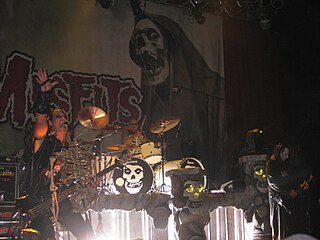
The Misfits are an American punk rock band often recognized as the pioneers of the horror punk subgenre, blending punk and other musical influences with horror film themes and imagery. The group was founded in 1977 in Lodi, New Jersey, by vocalist, songwriter and keyboardist Glenn Danzig. Over the next six years, Danzig and bassist Jerry Only were the group's main members through numerous personnel changes. During this period, they released several EPs and singles, and with Only's brother Doyle as guitarist, the albums Walk Among Us (1982) and Earth A.D./Wolfs Blood (1983), both considered touchstones of the early-1980s hardcore punk movement. The band has gone through many lineup changes over the years, with bassist Jerry Only being the only constant member in the group.
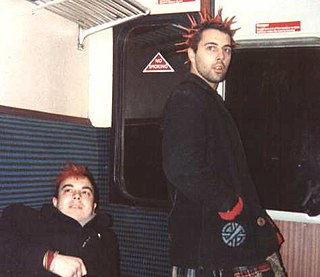
Punk fashion is the clothing, hairstyles, cosmetics, jewellery, and body modifications of the punk counterculture. Punk fashion varies widely, ranging from Vivienne Westwood designs to styles modeled on bands like The Exploited to the dressed-down look of North American hardcore. The distinct social dress of other subcultures and art movements, including glam rock, skinheads, greasers, and mods have influenced punk fashion. Punk fashion has likewise influenced the styles of these groups, as well as those of popular culture. Many punks use clothing as a way of making a statement.

Dez Cadena is an American punk rock singer and guitarist. He was the third vocalist and later rhythm guitarist for hardcore punk band Black Flag from 1980 to 1983. Cadena played guitar with Misfits from 2001 to 2015, initially joining the band alongside Doyle, Jerry Only, and Robo for their 25th Anniversary Tour.

Glenn Allen Anzalone, better known by his stage name Glenn Danzig, is an American singer, songwriter, musician, and record producer. He is the founder of the rock bands Misfits, Samhain, and Danzig. He owns the Evilive record label as well as Verotik, an adult-oriented comic book publishing company.

Horror punk is a music genre that mixes punk rock and 1950s-influenced doo-wop and rockabilly sounds with morbid and violent imagery and lyrics which are often influenced by horror films and science fiction B-movies. The genre was pioneered by the Misfits in the late 1970s and early 1980s. Subsequent bands formed in the Misfits' wake like Mourning Noise, the Undead and Samhain, solidifying horror punk's first wave. In the late 1990s and early 2000s the genre gained attention through the reunion of the Misfits and success of groups like AFI, Son of Sam and the Murderdolls. This popularity continued to the modern day with Blitzkid, Calabrese and Creeper.
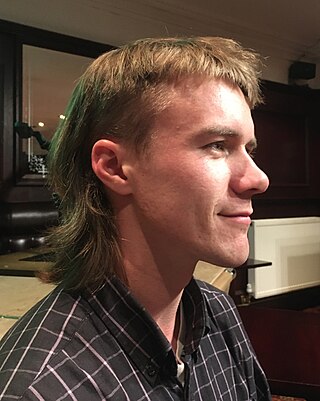
The mullet is a hairstyle in which the hair is cut shorter at the front, top and sides, but is longer at the back.
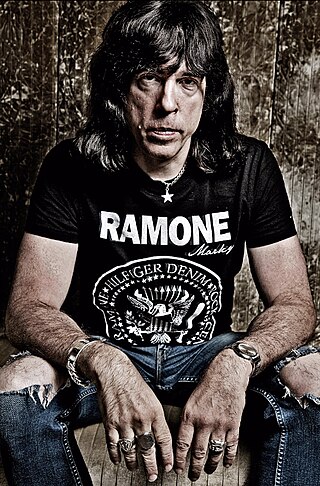
Marc Steven Bell is an American drummer. He began playing in hard rock bands in the New York City area, notably Dust and Estus. He was asked to drum for punk rock band Richard Hell and the Voidoids. He replaced drummer Tommy Ramone in the Ramones in 1978, and went by the stage name Marky Ramone from then on. He has also played drums for other punk rock and heavy metal bands, including his own band Marky Ramone and the Intruders. He continues to keep the Ramones legacy alive around the world with his band Marky Ramone's Blitzkrieg.
The Groovie Ghoulies were an American pop punk band from Sacramento, California, United States, whose music took inspiration from horror movies. They released numerous albums, EPs, and singles, and toured internationally. The band's name was taken from the 1970s animated television series Groovie Goolies, a spinoff of Sabrina, the Teenage Witch.
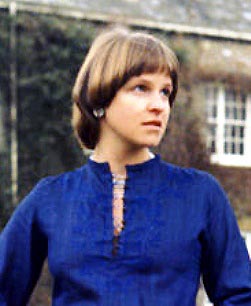
The pageboy or page boy is a hairstyle named after what was believed to be the haircut of a late medieval page boy. It has straight hair hanging to below the ear, where it usually turns under. There is often a fringe (bangs) in the front. This style was popular in the mid-to-late 1970s and 1980s.

Liberty spikes is hair styled into long, thick, upright spikes. The style, now associated with the punk subculture, is so named because of the resemblance to the diadem crown worn by the Statue of Liberty, itself inspired by the Roman goddess Libertas and god Sol Invictus.
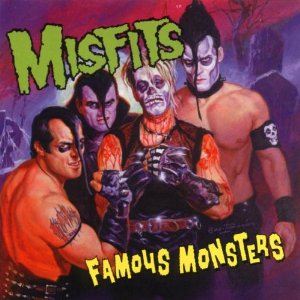
Famous Monsters is the fifth studio album by the American punk rock band Misfits, released on October 5, 1999. It is the second in the post-Danzig era of the band, and the last album to feature Doyle Wolfgang von Frankenstein, Michale Graves, and Dr. Chud, who would all quit the band in 2000.
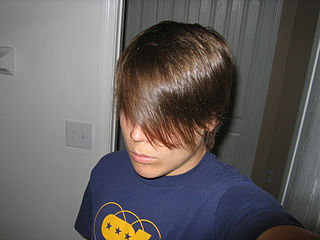
The tellum or reverse mullet is a hairstyle similar to the mullet. "Tellum" is "mullet" spelled backwards. While a mullet is short in the front and long in the back, the opposite is true for a tellum. The hair is longer in the front, and is short/buzzed in the back. The back is often spiky as well. It is not uncommon that the back layers of hair are dyed a different color than the front, or that there are drastically different colored streaks (highlights/lowlights) running through the front of the hair.

Paul Caiafa, known professionally as Doyle Wolfgang von Frankenstein, is an American guitarist best known for his material with the horror punk band the Misfits and his own band eponymously named Doyle.

Big hair is a hairstyle that emphasizes large volume or largely styled hair, especially when those styles make the hair occupy a large amount of space above and around the head. The label "big hair" for such styles originated in the late 1970s, when these styles were beginning a period of popularity. Similar styles have become fashionable at various periods in history.

The wings haircut, also known the Mod haircut, Mop top, flippies, flow, Justin Bieber haircut, or skater hair is a popular hairstyle used in the skateboarding, surfer, mod, and preppy community. Typically long, the style can range from long and drooping below the eyes, to a shorter length. The haircut is typically wavy and, if straight, the length comes to halfway down the ears. Instead of lying on the wearer's ears, the hair flips up and comes straight out like an airplane wing, hence the name. The hairstyle was popular among men in the 1960s, 1970s, mid-late 2000s, early 2010s and 2020s.
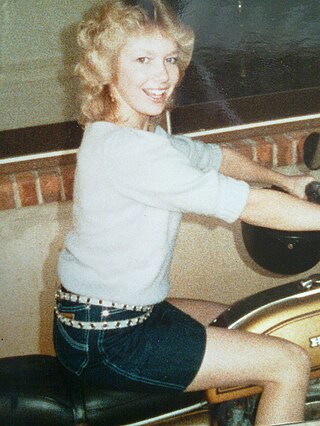
Hairstyles in the 1980s included the mullet, tall mohawk hairstyles, jheri curls, flattops, and hi-top fades, which became popular styles. Amongst women, large hair-dos, puffed-up styles, permanent waves, and softer cuts typified the decade. Big hair that was "often permed to achieve the desired volume" is especially associated with women of the mid 1980s as well as male rockstars of that era, especially of the glam metal genre. Television shows such as Dynasty helped popularize the high volume bouffant and glamorous image associated with it.

















